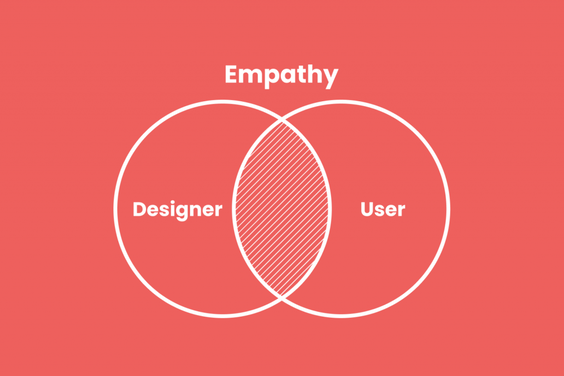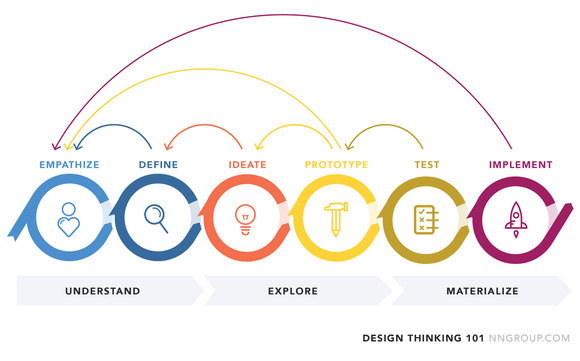
There are many ways UX writers can contribute to the design process and foster collaboration, but the easiest is to be curious and ask good questions.
UX writers are like detectives; they need information from many sources to create a solution. Ask any good detective how they clarify the facts, solve the puzzle and find the truth, andthey’ll tell you the solution is in the questions.
Design thinking is a creative, collaborative process—a team sport. Yet, too often it is played like a solo sport, with individual team members waiting to make their own plays when the ball is passed to them.
A symptom of this is asking few questions in the front end of projects (e.g kickoffs, etc.). Whether caused by fear or a knowledge gap, or just a habit of deferring to product for direction,
the result is the same – too few questions to inform the work.
UX writers can fill this gap with good questions. Since we don’t arrive with the solutions,
it's beneficial to demonstrate how we find the solutions.
4 benefits of asking good questions during the initial stages of the design process:
UX writers are like detectives; they need information from many sources to create a solution. Ask any good detective how they clarify the facts, solve the puzzle and find the truth, andthey’ll tell you the solution is in the questions.
Design thinking is a creative, collaborative process—a team sport. Yet, too often it is played like a solo sport, with individual team members waiting to make their own plays when the ball is passed to them.
A symptom of this is asking few questions in the front end of projects (e.g kickoffs, etc.). Whether caused by fear or a knowledge gap, or just a habit of deferring to product for direction,
the result is the same – too few questions to inform the work.
UX writers can fill this gap with good questions. Since we don’t arrive with the solutions,
it's beneficial to demonstrate how we find the solutions.
4 benefits of asking good questions during the initial stages of the design process:
- Reveal core user needs
- Trigger imagination and opportunities
- Foster collaboration
- Bonus! Expose the value of UX writing at a strategic level
 Courtesy Interaction Design Foundation
Courtesy Interaction Design Foundation
1. Questions Reveal Core User Needs
Corporate environments are short on time and big on ideas. And that’s a good thing. The challenge rests in deciding what ideas to pursue. Taking a cue from user-centered design
reminds us that the best ideas are the ones that solve user needs.
Good questions can shine a light on the user because they:
Find the core need
Doctors repeat a mantra of “treat the disease, not the symptoms” for a reason. If a user isn’t using a feature, promote the feature. But what if the feature isn’t actually what they need? Instead, focus on the origin of the symptom and asking good questions to make a good diagnosis.
Map the situation
It’s easy to get micro-focused on projects, but often the most important information lies at a higher level. Asking the right questions about the user, need, and pain points helps to…
Understand context (through empathy)
UX writers/content designers can use different mapping techniques to gain a clear
picture of the context of the problem. The first step to understanding core user needs is empathy.
By using empathy, we take a step closer to understanding user’s behaviors and mental models.
Good questions help gain valuable insights and uncover social, economic, or cultural patterns
that take place in a particular context. This understanding helps us:
Corporate environments are short on time and big on ideas. And that’s a good thing. The challenge rests in deciding what ideas to pursue. Taking a cue from user-centered design
reminds us that the best ideas are the ones that solve user needs.
Good questions can shine a light on the user because they:
Find the core need
Doctors repeat a mantra of “treat the disease, not the symptoms” for a reason. If a user isn’t using a feature, promote the feature. But what if the feature isn’t actually what they need? Instead, focus on the origin of the symptom and asking good questions to make a good diagnosis.
Map the situation
It’s easy to get micro-focused on projects, but often the most important information lies at a higher level. Asking the right questions about the user, need, and pain points helps to…
Understand context (through empathy)
UX writers/content designers can use different mapping techniques to gain a clear
picture of the context of the problem. The first step to understanding core user needs is empathy.
By using empathy, we take a step closer to understanding user’s behaviors and mental models.
Good questions help gain valuable insights and uncover social, economic, or cultural patterns
that take place in a particular context. This understanding helps us:
1. Challenge assumptions (and reveal innovation)
Challenging assumptions is a technique used in the ideation process of design thinking.
People, teams, and organizations are predisposed to assumptions because our ideas
and convictions constantly shape our point of view, based on our habits, beliefs and processes.
Good questions help detect biases and find new perspectives and points of view.
Start today to challenge assumptions with good questions:
- What are we taking for granted?
- What are the assumptions that we’re making?
- What would happen if we challenged these assumptions?
- What if we did the opposite of what we’re doing now?
- What other possibilities are there?
When you challenge assumptions, you invite innovation.
Innovation stems from new viewpoints and perspectives—older viewpoints may not be effective
anymore. Assumptions can hinder the positive change you are looking for.
Challenging assumptions is fun. You’re exploring new ground and facing the unknown.
Optimism and joy, rather than fear.
2. Questions trigger Imagination and Opportunities
Great questions have the power to transform reality we take for granted. They free us from
conditioned thinking and elevate possibilities.
Questions can reframe a situation. Questions like, “What would happen if all humans could
buy this?” or “are we solving a business need or a user need?” can change our view of the
situation dramatically. When people see things from new perspectives, innovation happens.
Start your questions in a way to encourage imagination and promote new perspectives:
Great questions have the power to transform reality we take for granted. They free us from
conditioned thinking and elevate possibilities.
Questions can reframe a situation. Questions like, “What would happen if all humans could
buy this?” or “are we solving a business need or a user need?” can change our view of the
situation dramatically. When people see things from new perspectives, innovation happens.
Start your questions in a way to encourage imagination and promote new perspectives:
- What if…?
- What would change if…?
- What other way could we…?
- How would it be different if…?
- Suppose that…?
 Courtesy UX Planet
Courtesy UX Planet
3. Questions Foster Collaboration
A typical cross-functional design team brings different specialists together. Each has a primary
function -- product management, engineering, research, etc. Often project teams are so focused
on the title and role that they forget that the group shares responsibility for creative decision
making and the overall design thinking process.
Questions at the beginning of projects stir creativity, build respect and show interest in others’
feelings and thoughts. They clarify team goals, align team members, and give people ownership.
When you ask teammates questions, they reveal how they think, what they believe in, how they
feel in certain situations, etc. The creative process benefits from these unique points of view.
Ask questions in both the kick-off and the first team white-boarding session (highly recommended).
Questions during these sessions draw a team together and foster an environment of collaboration.
4. (Bonus!) Questions Expose the value of UX writing at a strategic level
Let’s be real, most cross-functional teams lack an understanding of what we do.
As a result, they default to basic thinking like, “They write the content.” That's part of it,
but great content requires a strategy and UX writers need information to shape that strategy.
Asking questions in the early stage of projects helps you get the information you need,
but it also shows leadership and offers visibility into the content design process.
As you ask questions, the team will align around the answers and recognize the information
you need for your craft. This helps clarify the work and what meetings you need to be part of. Ask questions like:
Let’s be real, most cross-functional teams lack an understanding of what we do.
As a result, they default to basic thinking like, “They write the content.” That's part of it,
but great content requires a strategy and UX writers need information to shape that strategy.
Asking questions in the early stage of projects helps you get the information you need,
but it also shows leadership and offers visibility into the content design process.
As you ask questions, the team will align around the answers and recognize the information
you need for your craft. This helps clarify the work and what meetings you need to be part of. Ask questions like:
- What data do we have?
- Are we solving for a business need or user need?
- How do we define the core user need and pain points?
- What works in our current experience? What content is missing?

The Anatomy of a Good Question
Now that we understand the benefits of asking good questions, let’s shift gears and look
at what makes for a good question.
Good questions challenge assumptions.
They help clarify the situation and cause teams to explore the beliefs and data that drive their actions.
Good questions should be open-ended.
Open-ended questions encourage people to reflect and reveal what’s important for them.
An open-ended question is a question that is open to any answer. In the context of design thinking, open-ended questions are ones that cannot be answered with a simple ‘yes’ or ‘no’, and instead encourage
colleagues to elaborate on their points.
Open-ended questions explore possibilities, feelings, and the reasons why. Michael J. Marquardt, author
of Leading with questions, describes some types of open-ended questions:
- Explorative questions force expansion on new points of view and uncovered areas. Have you thought of…?
- Clarifying questions help align and avoid misunderstandings. So, you mean that..?
- Affective questions reveal people’s feelings about something. How do you feel about…?
- Reflective questions encourage more elaboration. What do you think causes…?
- Probing questions invite a deeper examination. Can you describe how…?
Examples
Don’t (Closed)—Will this project improve the experience?
Do (Open)—How will this work improve the experience?
Don’t (Closed)—Do we know the problem we need to solve?
Do (Open)—How do we know it’s the right problem?
Don’t (Closed)—Dow we know the user?
Do (Open)—How do we know we have a clear view of the user?
Don’t (Closed)—Is the experience bad?
Do (Open)—What could improve this experience?
Good questions go beyond the obvious.
They should cause people to reflect and help them explore different solutions.
For example, instead of asking, “Can we do this?” you could ask “What are the trade offs to doing this?”
Good questions should open new possibilities.
They involve people in divergent thought processes that lead to new perspectives.
The goal is breakthrough thinking. For example, when designing a login screen, instead
of asking, “How can we make the login process faster?” you could ask, “How can we
deliver value to users without requiring them to log in?”
The Design Thinking Process Using Great Questions
Questioning is a powerful tool that we all benefit from using fluently. As part of a design
thinking process, questions can help understand a situation and get valuable insights.
They can also foster creativity and innovation within an organization, and can help teams align and unite.
As a UX writer/content designer, ask questions and make sure everyone understands they are rooted
in curiosity and a desire to create the best design solution (content + design).
Resources:
- https://careerfoundry.com/en/blog/ux-design/design-thinking-process/
- https://www.interaction-design.org/literature/article/5-stages-in-the-design-thinking-process
- https://medium.com/@iamdanandrews/design-thinking-with-a-solid-content-strategy-9d55a2e6f646/

Geoffrey O’Brian
Geoffrey is a UX writer/content designer and creative leader who uses content design to champion user needs and help businesses create user-driven content.
